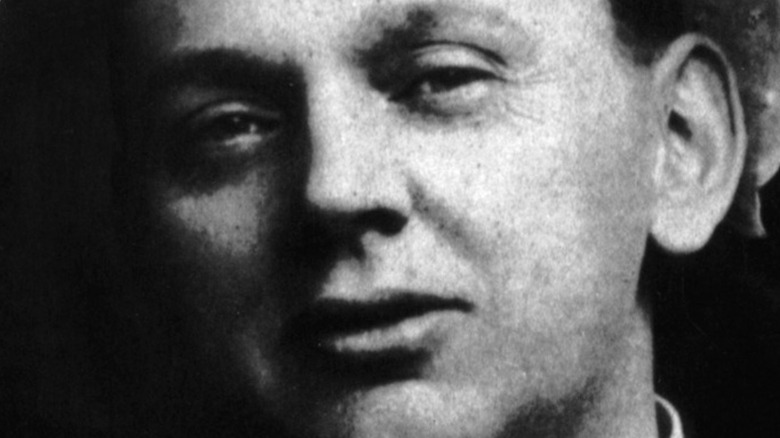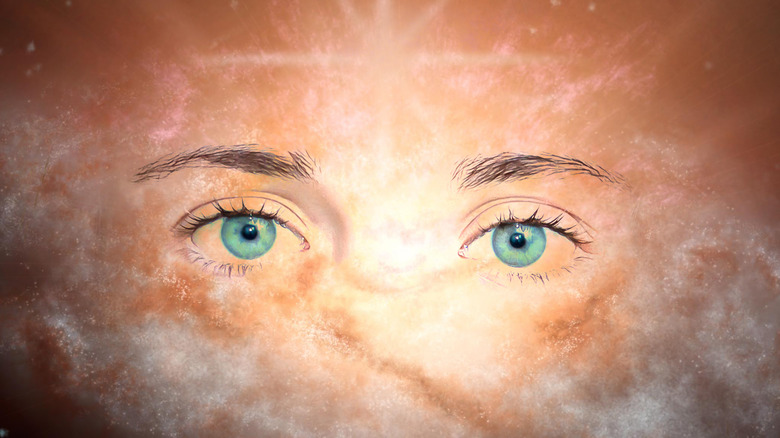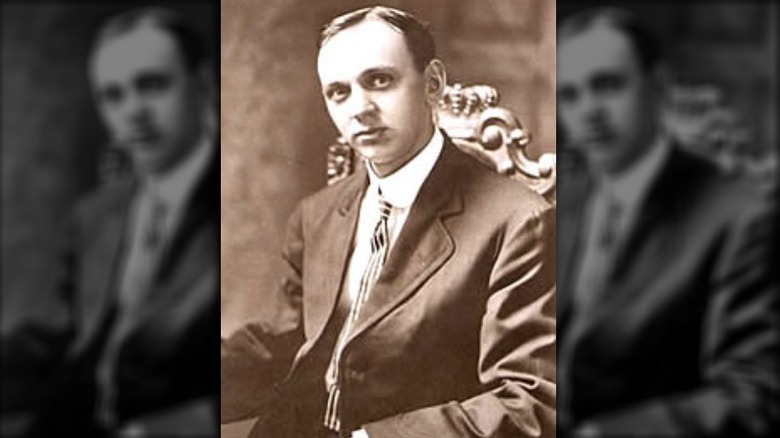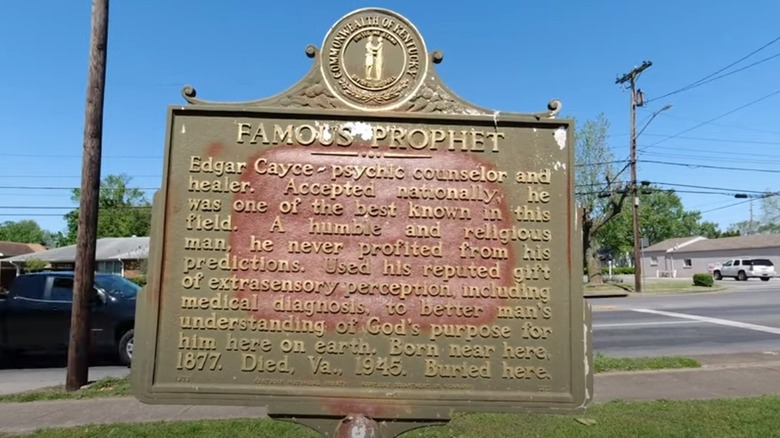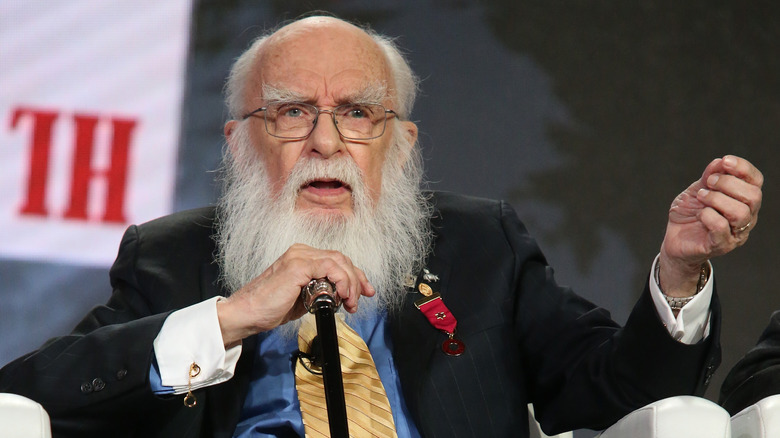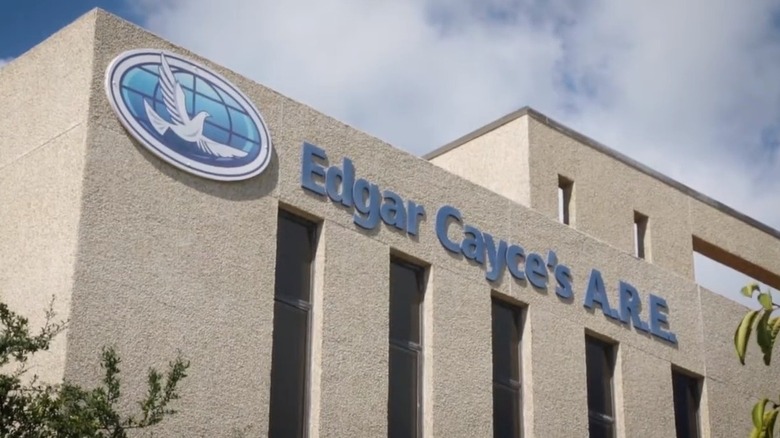The Bizarre Story Of Edgar Cayce, The Sleeping Prophet
One of the most important figures of the spiritualism boom of the late 19th and early 20th centuries, Edgar Cayce is arguably the most notable mystic since Nostradamus. A continuing influence on the modern New Age movement, his teachings, philosophy, and prophecies have influenced generations of occultists and believers in the supernatural. From holistic healing to his ideas about the famous lost continent of Atlantis to his predictions of things to come, there is virtually no area of psychic phenomena, the paranormal, or the unknown untouched by Cayce's legacy.
Dubbed the "Sleeping Prophet" for the deep trances in which he made his "readings." Cayce, allegedly under the guidance of otherworldly entities, was said to be able to diagnose and suggest treatment for illnesses and injuries with astonishing accuracy. While in his sleeping state, he also answered questions about topics both commonplace and esoteric. During his lifetime, thousands of recordings were made of his readings which cover topics such as lost civilizations, the origins of the human race, religion, future events, and more.
Claiming he had no memory of his words while in the trance state, Cayce presented the image of an unassuming everyman who himself was baffled by his incredible abilities. Despite his reputation in the New Age community, the Kentucky-born clairvoyant is not without his detractors. Skeptics are quick to point out that believers tend to emphasize Cayce's psychic "hits" over his "misses." Shaman or charlatan, this is the bizarre story of Edgar Cayce, the Sleeping Prophet.
Edgar Cayce's early visions
As detailed in "Edgar Cayce, The Sleeping Prophet" by Jess Stearn, Edgar Cayce was born on March 18, 1877, on a farm near Hopkinsville, Kentucky. Initially, there were few signs that Edgar was anything other than a typical, albeit very pious, youth. The only other member of the Cayce family to exhibit any kind of paranormal ability was his grandfather. The elder Cayce was a skilled dowser who could locate water using a forked branch cut from a witch hazel tree.
A serious child, Edgar Cayce didn't care for play. His favorite activities were attending church and reading the Bible. According to "There is a River: The Story of Edgar Cayce," little Edgar also enjoyed the company of childlike entities whom only he could see. The beings, who seemed to age along with Cayce, claimed to live "in the flowers and the music of everything." Cayce also claimed to have seen the apparition of his dead grandfather.
Cayce was not yet 10 years old when he had a life-changing mystical experience. While reading the Bible in a favorite spot in the forest near his family's home, Cayce encountered a winged woman with a musical voice who told him, "Your prayers have been heard. Tell me what you would like most of all, so that I may give it to you." Inspired by the story of Christ and his disciples, Cayce answered, "Most of all I would like to be helpful to others and especially to children when they are sick."
Cayce's gifts first manifested in childhood
Distracted by memories of the angelic woman in the woods, Cayce's studies suffered. Tasked with staying after school to write "cabin" 500 times on the blackboard after being unable to spell the word in class, Cayce knew more punishment awaited when he finally returned home. Late into the night, Cayce's furious father repeatedly quizzed his son on his spelling lessons. When the youth still couldn't give the correct answers, his father struck Cayce, knocking him to the floor. With the blow still ringing in his ears, he once again heard the melliferous voice of the angel. "If you can sleep a little, we can help you," it said. Exhausted, Cayce rested his head on his spelling book and dozed. As detailed in "There is a River," when he awoke, he miraculously knew every word in the text. To his amazement, he discovered it was the same with every subject. Consequently, his studies improved, and the once poor student advanced to the next grade ahead of schedule.
Soon after, the strange ability that would make Cayce a world-famous psychic healer manifested for the first time. During a schoolyard game, Cayce was struck in the back by a ball and suffered a spinal injury that left him in shock. That night, as Cayce seemingly slept, he recited the ingredients for a poultice he claimed would heal his injury. With nothing to lose, his parents prepared and applied the remedy. Upon awakening the next morning, Cayce was free of pain but remembered nothing of the previous night.
Edgar Cayce agonized over the source of his power
As Edgar Cayce grew into young adulthood, he came to question the source of his incredible power and the meaning of his vision of the winged woman in the forest. As a devout Christian who prided himself on having read the Bible once for every year of his life, doubts about his abilities and their purpose crept into his mind. His father's propensity to brag about Cayce's prowess for "knowing" the contents of any text just by sleeping on it and his willingness to exploit his son's talents to gratify his ego left the young man further conflicted about his purpose.
As documented in "There is a River," Cayce's grandmother attempted to ease his mind with tales of his psychically adept grandfather. "You're a great deal like your grandfather," she told Edgar. "It may be that you have the same powers. ... He could make tables and chairs move and brooms dance without touching them. But he never made a show of it. He used to say to me, 'Everything comes from God. ... The Lord said there is set before each of us good and evil, for us to choose. So if I spend my time ... doing tricks for people's entertainment, that would be choosing evil.'"
Still, Cayce's mysterious abilities gave him pause. However, a chance meeting with famed evangelist Dwight L. Moody did much to allay his concerns. When he told Moody of his childhood vision, the preacher explained to Cayce that he was not insane, nor was he alone.
Cayce and the hypnotists
At age 21, Cayce, then working as an insurance salesman, became ill and unable to speak. Despite the best efforts of his doctor, Cayce's laryngitis seemed incurable. Robbed of his voice, Cayce could no longer sell insurance. For months, he languished at his parents' home, praying for a miracle.
As documented in Gina Cerminara's book "Many Mansions," a traveling hypnotist known as Hart got word of Cayce's condition. Convinced he could restore Cayce's voice through hypnosis, Hart invited the young man to take part in an experiment. While Cayce was under hypnosis, his voice returned to normal, but upon waking, it again disappeared. Defeated, Hart turned Cayce over to a local hypnotist named Layne, who was also unsuccessful. In a last-ditch attempt to restore Cayce's voice, Layne instructed his hypnotized subject to describe his condition. Speaking from his trance, Cayce intoned, "Yes, we can see the body. ... In the normal state, this body is unable to speak, because of a partial paralysis of the inferior muscles of the vocal cords ... This is a psychological condition producing a physical effect. It may be removed by increasing the circulation to the affected parts by suggestion while in the unconscious condition."
Layne then made a hypnotic suggestion to increase blood flow to Cayce's paralyzed vocal cords. He watched in amazement as Cayce's upper chest and throat became flushed. Within minutes, Cayce informed Layne that his condition was cured. When Cayce awoke, he spoke normally for the first time in over a year.
Edgar Cayce: psychic healer
After witnessing Cayce's amazing feat of successfully diagnosing his own malady while in a trance, Layne asked his subject to take part in one more experiment. This time, Cayce would attempt to assess the hypnotist's physical condition. As detailed in "Edgar Cayce, The Sleeping Prophet," Cayce once again entered the trance state. As before, Cayce spoke, "Yes, we have the body..." He then rattled off all of Layne's ailments and their corresponding remedies, which the hypnotist quickly scrawled down. When Cayce awoke, he had no memory of diagnosing Layne, nor did he understand the unfamiliar medical terms he had spoken.
Still, Cayce's newfound gift was a challenge to his faith. "Why should God pick out somebody like me and give him this strange power?" he wondered. Convinced by his fiancée Gertrude Evans that his ability was divinely bestowed, Cayce began performing twice-daily diagnostic readings on the sick and injured.
In the summer of 1902, a reading performed on the ailing 5-year-old daughter of Dr. C.H. Dietrich, the former Hopkinsville school superintendent, changed Edgar Cayce's life forever. Doctors had determined that the little girl had a fatal brain affliction, but Cayce's diagnosis found she had actually suffered a spinal injury. A readjustment of the girl's vertebrae resolved her condition, and within months, she recovered. A grateful Dietrich told Dr. Wesley Ketchum about Cayce's miraculous abilities. Ketchum would later use Cayce as a psychic diagnostician, setting the sleeping healer on the path that would define his life.
Cayce refused to accept money for his readings
Edgar Cayce's devotion to his Christian faith and his firm belief that his abilities were a gift from God to be shared with the world precluded him from accepting payment for readings. Consequently, he lived much of his life on the edge of poverty.
Cayce's silent partnership with Al Layne ended when state medical authorities closed Layne's office. As a hypnotist whose medical education consisted of a mail-order course in osteopathy, Layne lacked the medical knowledge and training to continue his unusual healing practice. Edgar Cayce returned to his trade as a photographer. As documented in "There is a River," for a while, Cayce operated two successful photography studios in Bowling Green, Kentucky. Sadly, both businesses were destroyed by fire, leaving Cayce bankrupt and nearly destitute.
After experiencing Cayce's otherworldly diagnostic powers firsthand, a Hopkinsville doctor named Wesley Ketchum offered Cayce the opportunity to become part of his practice. Impressed with Cayce's skills, the young doctor assured the reluctant clairvoyant that he could virtually name his price if he agreed to go into business with him. Cayce was in, but he had specific terms for the use of his supernatural gift. "It must be understood that I am not to consider this as a profession, or a means of livelihood," Cayce wrote in a letter to Ketchum. Cayce's only demands were that he be set up with a photography studio furnished with no less than $500 worth of equipment and an office for performing his readings.
A sleeping prophet of doom
Edgar Cayce's amazing talent wasn't limited to making medical diagnoses. While in his sleep-like trances, he made a number of astonishing predictions about future events — many of which seem to have come true.
Six months before the 1929 stock market crash that precipitated the Great Depression, Cayce warned his investor friends to sell all their stocks. Doubting Cayce's acumen for finance, they soon found themselves penniless. In 1931, he accurately predicted that the worldwide economic downturn would end in the spring of 1933.
As documented in the 2005 documentary "Decoding the Past: The Other Nostradamus," in 1935, Cayce predicted the outbreak of World War II. Foreseeing an alliance between Austria, Germany, and Japan, Cayce warned that without divine intervention, the whole world would be "set on fire." Cayce also predicted that two U.S. presidents would die while in office (Franklin Delano Roosevelt died in 1945 before the end of his fourth term, and John F. Kennedy was assassinated in 1963) and that the United States would go through a period of civil and racial strife.
However, the Sleeping Prophet's most disturbing predictions are for events yet to come. According to Cayce, the Earth is in for some catastrophic geological changes which will reshape continents and nations. Among the most shocking of Cayce's Prophecies are predictions of massive earthquakes on both the East and West Coasts of the United States which will result in the complete destruction of New York, Los Angeles, and San Francisco.
Cayce's readings versus his faith
During his partnership with Dr. Wesley Ketchum, Cayce began having headaches after his readings. Soon, Cayce discovered that Ketchum had been taking advantage of the fact that he was completely unaware of what transpired during his sleep sessions. Ketchum had falsified reports about some readings and had also used Cayce's abilities to gamble. Although Ketchum claimed he did it for the good of their practice, the dishonesty was the last straw for Cayce.
Despite his belief that his powers were divinely inspired, Edgar Cayce at times found the words he spoke in his readings at odds with his faith. When Arthur Lammers, a wealthy man with an interest in metaphysics and philosophy requested readings on esoteric, supernatural subjects, Cayce initially balked out fear that he would be giving Satan an open invitation to speak through him. However, he relented after giving some thought to Lammer's request, believing he had at last found an opportunity to definitively join his belief in the Bible with his strange power.
According to Thomas Sugrue, author of "There is a River," the results of his readings with Lammers seemed to verify the validity of astrology and reincarnation, concepts antithetical to Cayce's beliefs. The clairvoyant struggled to reconcile the ideas with his religion. However, he at last determined there was a logic and moral soundness to what he had said in the sleep state.
Atlantis and the origins of civilization
Atlantis, first described by Plato over 2,400 years ago as an advanced nation that once conquered much of Africa and Europe before losing the favor of the gods and sinking into the sea, has fascinated both scientists and believers in the unknown for centuries. In his visions, Cayce saw Atlantis as a highly technological society that was eventually destroyed through its own self-destructive nature. As detailed in "Edgar Cayce, The Sleeping Prophet," Cayce believed that before the cataclysm, many Atlanteans had fled to the areas of the planet that are the present-day locations of Egypt, Mexico, Peru, Central America, New Mexico, and Colorado. In some of Cayce's readings, he stated that the United States was a modern analogue of the lost continent and that many of its citizens were reincarnated Atlanteans.
In 1940, Edgar Cayce predicted that portions of Atlantis would be discovered in "1968 or '69" and that secrets of their incredible technology would be found "in the sunken portions of Atlantis ... under the slime of ages of seawater, near what is known as Bimini, off the coast of Florida." Cayce devotees point to the 1968 discovery of the Bimini Road, a formation of uniform, rectangular limestone tiles found beneath the waters off the Bahamas, as evidence of the psychic's insight.
The death of Edgar Cayce
In 1925, Edgar moved to Virginia Beach, Virginia, at the behest of a voice he heard during one of his trances. The move to Virginia Beach marked Cayce's busiest period, during which he became a professional psychic.
During his last years, Cayce's readings became more centered on spiritual and philosophical topics. The 1943 publication of the biography "There is a River" by Thomas Sugrue and a feature story titled "Miracle Man of Virginia Beach" in the national magazine Coronet brought Cayce widespread attention. According to The Washington Post, celebrities ranging from Irving Berlin to a pre-fame Marilyn Monroe sought readings from the Sleeping Prophet.
Near the end of his life, Cayce dramatically increased the number of readings he gave per day. In August 1944, he collapsed under the strain. The following month, he suffered a stroke. On the evening of January 3, 1945, Cayce died. His final words were, "How much the world needs God today."
A skeptical perspective
Despite his reputation among legions true believers, Edgar Cayce is not without his detractors. The late magician, skeptic, and professional debunker James Randi was particularly critical of Cayce and his followers. To Randi, Cayce was an outright fraud no different than thousands of other supposed fortune tellers and psychics who use methods such as "cold reading" to ensnare the credulous.
In a 1979 "Skeptical Inquirer" article titled "The Slipping Prophet," he points out that many of Cayce's vaunted miracle cures were merely common 19th-century home remedies. (Apparently, Cayce prescribed beef broth for everything from gout to leukemia.) In regard to Cayce's diagnostic gifts Randi wrote, "Cayce was fond of expressions like 'I feel that' and 'perhaps' to avoid positive declarations. It is a common tool in the psychic trade." Overall, Randi explains Cayce's alleged accuracy as merely the product of his followers' tendency to accentuate his successes and explain away his failures.
Cayce's legacy and influence
Nearly 80 years after his death, Edgar Cayce continues to influence and inspire thousands who have chosen to adopt his holistic philosophies regarding body, mind, and spirit as a way of life. As documented by beliefnet, Cayce's ideas are a major influence on the New Age movement, with his readings and teachings introducing such terms as "spiritual growth," "aura," "soul mates," and "holistic health" into the popular lexicon.
The nonprofit Association for Research and Enlightenment (A.R.E), founded by Edgar Cayce in 1931 after the close of the Cayce Hospital, continues to operate from its Virginia Beach headquarters to the present day. With a stated mission of creating "opportunities for profound personal change in body, mind, and spirit through the wisdom found in the Edgar Cayce material," the A.R.E. runs centers promoting body-mind-spirit wellness throughout the United States.
Also located in Virginia is the Edgar Cayce Foundation. Founded in 1948, the Foundation archives materials relating to the Sleeping Prophet, including 14,307 documented readings.
